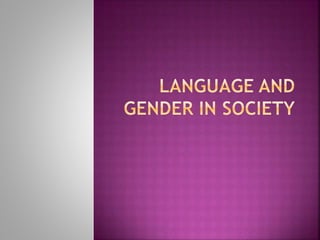
Language and gender in society
- 2. Since the dawn of human history, what makes people different from other creatures on the earth is their ability to use language to communicate with one another. When it comes to language, people define it as a system of communication based on words and sentences to make our communication meaningful and understandable. However, the ways language is used are not the same in different countries, by different people and by different genders. A major topic in sociolinguistics which has been discussed over the last few decades is whether men and women speaking a certain language use it in different ways.
- 3. Do men and women use language differently? If there are differences in the language used by different gender, what linguistic aspects are different? And what are the reasons for those differences. With a view to answering those questions, sociolinguists have been trying to carry out such a lot of research and surveys and lay out different thesis and theories for this issue. There are two important things sociolinguists did in their study about language and gender. The first one is the differences in linguistic aspects the two different genders use in their language. The second thing is the reason why there are such differences.
- 4. When we look at the linguistic literature, two different types of studies have been made .The first study tries to look at the societies where there are very clear differences in the language used by gender. The second one examines the society where there are preferential speech features in using language by gender. Those two types of studies cover all of the sociolinguists’ studies in the field of language and gender.
- 5. Generally, sociolinguists indicate that there are speech varieties used by men and women in some societies. In these societies a woman or a man cannot speak the language of the other gender. For that reason, the varieties are considered as gender-exclusive speech.
- 6. According to Baron (1986), the most typical example of gender difference is found among the Carib Indians. He reports that male and female Caribs speak different languages. Their children are described having different languages as the boys learn language from their fathers and girls learn language from their mothers.
- 7. Lakoff (1975) and Holmes (1992) also claim that in some languages, the male speaker’s form is longer than that of the female’s. For example, women are more likely to say “Will you help me with these groceries, please ? ” than to say“ help me”
- 8. In addition to standard and non standard, some studies find differences in word choice, vocabulary and morphology used by men and women. Ekka (1972 as cited in Fasold, 1990, p91) found that there are several morphological forms used by women only when a In many societies, different genders show a preference for using certain linguistic features more than others. One of the claims is that women use more socially accepted variants of language than men. This means that women generally choose and use forms which are much closer to the standard ones more frequently than men. ddressing other women.
- 9. 1. Social status: According to Holmes (1992) women are more status conscious than men. Therefore, they use the standard form more. Further support for this explanation is the fact that women in New York (Labov) and Norwich (Trudgill) reported that they used more standard forms than they actually did .It was speculated that women lack the social status because they do not have a social identity which is usually obtained through work. Since language defines class, the use of the standard variety becomes more important to them.
- 10. 2. Guardian of society’s values In many societies women are expected to be better behaved than men. Little boys are given more leeway than girls and girls’misbehaviours are more often corrected. Similarly, rule breaking by women is frowned upon because women are supposed to be models of correct behaviors in community. For example, in Australia school teachers especially the primary school teachers are considered to be the models for their students, so they must be selected through a strict process in which they are tested carefully by the police. This explanation may be true in some social groups but according to my observation, in the relationship of family members. The language used between family members seems to be more relaxed and informal. In this case we cannot expect the mother or the father and their children to use standard language to communicate. Instead, the mother will try to speak as similarly to the way her children speak the language as possible. This is the situation where we have to accept more vernacular forms.
- 11. THANK U
